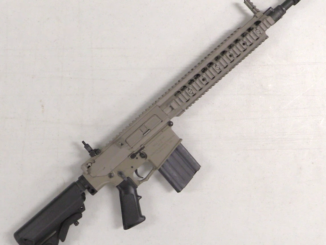Russell turner was a gunsmith and inventor in Pennsylvania who submitted a rifle design to the US Light Rifle trials (which would culminate in the adoption of Winchester’s design as the M1 Carbine). Turner’s entry into the first trial was a distinctive piece with a tubular metal stock and hand guard. This was criticized by the testing board, and his followup rifle in the second trial instead used traditional wooden furniture.
Unfortunately for Turner, the ammunition he was initially supplied for his development was loaded with IMR 4227 powder, and the ammunition used in the trials was a second lot made instead with Hercules 2400. While the two lots had the same maximum pressure, they had different burn rates and pressure curves and the trial ammunition did not run reliably in Turner’s rifle. Turner had not bee informed of this change, much to his disgust – he claimed that it would have been simple to adjust his rifle’s gas port location to work with the trials ammunition, and said that the gun ran perfectly with the ammunition he was supplied.
The Turner rifle is a pretty simple and handy design. It uses a long stroke gas piston and a side-locking tilting bolt, somewhat like the Czech ZH-29. It has a very simple trigger mechanism, and weighs in at 5.25 pounds unloaded. The safety copies that of the M1 Garand in operation, and the sights are a simple fixed aperture and front post. Had it not been for the pressure curve issues, it could have potentially been a real contender for adoption in my opinion.




Interesting considering how similar the ammo issues with the roll-out of the M16 would prove to be.
That reminded me about Kelly’s Johnson 14 rules
http://lockheedmartin.com/us/aeronautics/skunkworks/14rules.html
which were created for aviation industry, but some might be applied outside. In this case, I want point:
5. There must be a minimum number of report required, but important work must be recorded thoroughly.
–
Conclusion: cartridge and self-loading rifle is system, that mean before applying any significant change to one of it, it should be tested as whole.
It’s a wonder that early self-loading rifle designers did not routinely hedge their bets by intentionally overgassing the action, AK-style, to accept a wider quality range of ammunition.
I’m very glad to see that Rock island Auction changed its website to a different layout, because in the old version I would get a blank page whenever using this 3 y.o. web browser on this last-century notebook PC (and have to pull the page code in order to read the description or view images).
https://www.rockislandauction.com/detail/69/3427
“early self-loading rifle designers did not routinely hedge their bets by intentionally overgassing the action, AK-style, to accept a wider quality range of ammunition.”
Most self-loading rifle which were good enough to enter service, were designed years after cartridge it was firing was adopted and thus set of available loadings was well known.
Notice that on the other hand you can NOT apply too much force, as it might lead to case-bullet separation, this was especially problems with early machine gun chambered for cartridges designed for repeating rifles or even single-shot rifles.
.450 Mars Long cartridge for MARS automatic pistol
http://www.municion.org/mars/450MarsLong.htm
is example of cartridge with heavy crimping applied to avoid separation, as mechanism of that automatic pistol was not mild in operation.
Problems with bullet-case separation also occurred in DS-39 machine gun:
http://world.guns.ru/machine/rus/ds-39-e.html
at time of its introduction Degtyarov has support of Stalin, so his machine gun was pressed into service, but proved to be unreliable and even worse – unfixable, despite alterations made it never become satisfactory in field service. It was replaced by SG-43, which work as intended. Degtyarov himself in memoirs (Дегтярев В. Моя жизнь, Воениздат, 1951.) silently omit this machine gun.
Since the 7.62x54R case has a rather long neck, it would seem to provide an inherently robust platform for firmly seating the bullet in a harsh auto-loading environment such as a machine gun. In contrast, various other cartridges originally designed for bolt-actions have much shorter necks, like the .300 Winchester Magnum, which would imply that the bullet could be pried loose from the case much more easily.
In fact DS-39 work more reliable with newer 7.62x54R cartridge using steel-case tombac-plated case, but in front-line service avoiding older cartridge (still sitting in big numbers in stockpiles) was not possible. It was tested with ShKAS [enhanced to work properly with high RateOfFire of that weapon] cartridge and worked better.
–
“In contrast, various other cartridges originally designed for bolt-actions have much shorter necks, like the .300 Winchester Magnum,”
Cartridges designed for repeating rifles, are sometimes long-neck, sometimes short-neck, I never investigated why this or that is used, or maybe it is totally random choice.
One general empirical observation is that (most) tubular magazine fire-arms use long-neck cartridge, as magazine spring try all the time to push bullets inside case.
The safety lever may look a bit like the Garand, but the trigger group looks more like the Browning A5 shotgun. The M1 Garand trigger group is quite a bit more sophisticated than this one.
You gotta give Turner an “E” for effort. ^__^ Scorch marks inside the stock show that it was function tested quite a bit.
There’s load data for IMR 4227 for the .30 Carbine so you could reproduce the loading that functions the gun properly.
Patents related to this firearm:
https://www.google.com/patents/US2365142
https://www.google.com/patents/US2539644
That second one has 14 patent citations, (that the inventor deemed “related”), interesting reading. ^__^
On a side note, I use IMR 4227 to load all of my 30 Carbine ammo, it works great every time. Interesting to see they used it in the first batch. Great work Ian!!
Apparently it never occurred to Turner that some dimwit would foul things up with powder supply sources. Perhaps he could have asked if ammunition was expected to come from a single source or if mixed batches were to be anticipated in the field. I suspect the latter case to be true if we are talking about trying to fill the quota for ammunition headed for the front lines. So sadly for Turner, the guys running the trials seemed to think “a bullet is a bullet is any other stinking bullet” so long as the case and projectile are EXACTLY THE SAME for each cartridge regardless of the composition of the propellant for each individual batch of ammunition (from whom did this ammo chest come?).
If I recall, some idiot bureaucrats decided “oh, let’s get really cheap 5.56 NATO since every cartridge we see of the stuff must be the same,” which resulted in many M16’s fouling up quickly and backfiring their bolts right into the users’ faces, killing them in a most horrible manner (without a cleaning kit, there was no way to keep soot/powder residue from clogging the barrel).
Did I mess up?
“many M16’s fouling up quickly and backfiring their bolts right into the users’ faces”
Do you have a reference for that? I have to ask given that since the bolt carrier in the AR-15/M16 retracts into the buffer tube in the shoulder stock they’d have to aim by resting the butt stock on their chins to get a backfiring bolt in the face.
Well that was an overblown fear, sorry about that. But if by chance the receiver section were over stressed by fouling induced backfire, wouldn’t it harm the user? Or would the barrel burst before that? I don’t have much cleaning experience (sadly because I don’t have a gun), but if you should try shooting with something stuck in the barrel, something bad will happen…
I see, so that was your “Was it over when the Germans bombed Pearl Harbor” moment.
Quit moving the goal posts. First it was bureaucrats buying cheap 5.56mm ammo and now it’s stuff stuck in the bore.
And there’s a significant difference between powder fouling and “something stuck in the barrel”.
But yes, of course if you fire with a barrel obstruction something bad will indeed happen
http://slideplayer.com/slide/4555997/
Given your reference to no cleaning kits you aren’t talking about that whole ball powder vs IMR powder thing with the M16 back in the 60’s? That led to jams not backfires.
“(…)oh, let’s get really cheap 5.56 NATO since every cartridge we see of the stuff must be the same(…)”
This is one of examples that excessive saving is not good idea and will backfire sooner or later, with introduction of breech-loading fire-arms there was objection that soldiers armed with it will run out of ammo quickly. Until Schlacht bei Königgrätz (1866) where similar sized Austrian forces fight with Prussian forces, but as first were using muzzle-loaders and second breech-loaders, losses of Austrian forces were about 3 times higher.
This was clear signal that days of muzzle-loaders are gone, and its time to reequip to breech-loader. To avoid waste of rifles wide variety of conversions were invented and introduced, in caliber matching that of existing barrel.
It was soon found that smaller-caliber is more effective and again reequip was needed. British Empire found way to save some money here: cases of new .577/.450 were made from brass foil, but it give unreliable extraction in real combat and thus has to be replaced with more modern-style cases.
Cool little rifle. Every time I watch one of these light rifle prototype videos I’m happy that the Winchester entry ultimately won.
What would the hierarchy of Self loading designs by powder pressure curve sensitivity be? I would think blow back with some over travel would be the lease picky, maybe roller locked next… would direct impingement gas operated be the most pressure curve sensitive?
Some Soviet designed weapons (like ГШ-23, НР-30, 2А42, 2А72) use пиропатрон
https://ru.wikipedia.org/wiki/Пиропатрон
which allows remote cycling of weapon, especially aviation autocannons where it is impossible to manual cycle. It is basically blank cartridge, which fired deliver energy to cycle weapon.
Example: пиропатрон ППЛ photo:
https://reibert.info/threads/piropatron-ppl.177214/
This, the first model (or improved second model) Hyde and the Winchester could’ve had a pretty sweet face off.
Such a shame.
An interesting rifle of real “Inertia Firing Pin” and real “Long Stroke Gas Piston”.
When looking at the disassembled rifle, the case and the action parts need VERY much machining time. It resembles the Luger pistol. Knowing that the carbine was to be made quickly in sufficient numbers at a reasonable price, the people of the testing facility must have considered this and have it rejected for this reason alone.
I agree with Dave McIntyre, the Winchester version was the better choice.
It was possibly not a dimwit which changed the powder but someone decided it intentionally – to outwit the other competitors. In this case only the manufacturer of the ammunition knew about the change – and was also a competitor with a design of his own. Even better, at this time the only one with the possibility to make weapon and ammo perfectly working together.